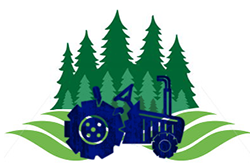
Agricultural and Forest Lands
Skagit County prides itself on its protections for its natural resource lands.
Agricultural Lands
Over the years, Skagit County has developed a number of mechanisms to help preserve working farmlands. Our Skagit River valley is blessed with some of the most productive agricultural soil in the world, and our overarching goal is to ensure those prime soils are preserved for farming.
Zoning Restrictions
Through a zoning modification in 1979, the County established a 40-acre minimum lot size for lands zoned Agricultural—Natural Resource Lands (Ag-NRL). This minimum lot size ensures that property is not divided into farmland parcels that are too small to be productive. Combined with strong restrictions on non-agriculture uses of farmland, this zoning code helps maintain the roughly 89,000 acres of Skagit farmland that supports an annual industry worth several-hundred-million dollars.
Easement Purchases and Incentives
The Skagit County Farmland Legacy Program purchases agricultural conservation easements using proceeds from a countywide conservation futures tax fund. Landowners retain ownership of their land and continue to farm, while the easement restricts future uses to agriculture. Established in 1997, the County’s Farmland Legacy program celebrated its 25th year in 2022. It is one of the most active and successful farmland preservation programs in the state of Washington. At the 25-year mark, the program has protected 14,000 acres of fertile Skagit County farmland, preserving its agricultural productivity for future generations.
The Skagit County Agricultural Land Preservation Code (SCC 14.16.860) zoning provision allows for the subdivision of a lot of record in Ag-NRL or RR-NRL into a one-acre tract for an existing house when the property owner donates by a conservation easement for the remainder. Many thousands of acres have been protected through this inventive mechanism.
Forest Lands
Skagit County has similar restrictions on forest land. Nearly a million acres of the County is covered in forest. While much of that is federally owned, the privately held parcels are protected from uncontrolled development through strong zoning protections.
Zoning Restrictions
The County’s commercial forest zoning consists of Secondary Forest, which has a 20-acre minimum lot size; and Industrial Forest, with an 80-acre minimum lot size. As in Ag-NRL, residential development in forest land is constrained by zoning. In Industrial Forest, residences must be accessory to timber management, located within 200 feet of a County road or state highway, and located within a fire district.
Forest Practice Rules
Forest practices are governed by the Washington State Forest Practice Rules and RCW Chapter 76.09. Some forest practices on some lands likely to be converted are governed by SCC 14.24.110 to ensure protection of critical areas. A 6-year moratorium on development applies to lands where forest practices have occurred, unless the forest practice was properly reviewed and approved for conversion from forestland to development.




















